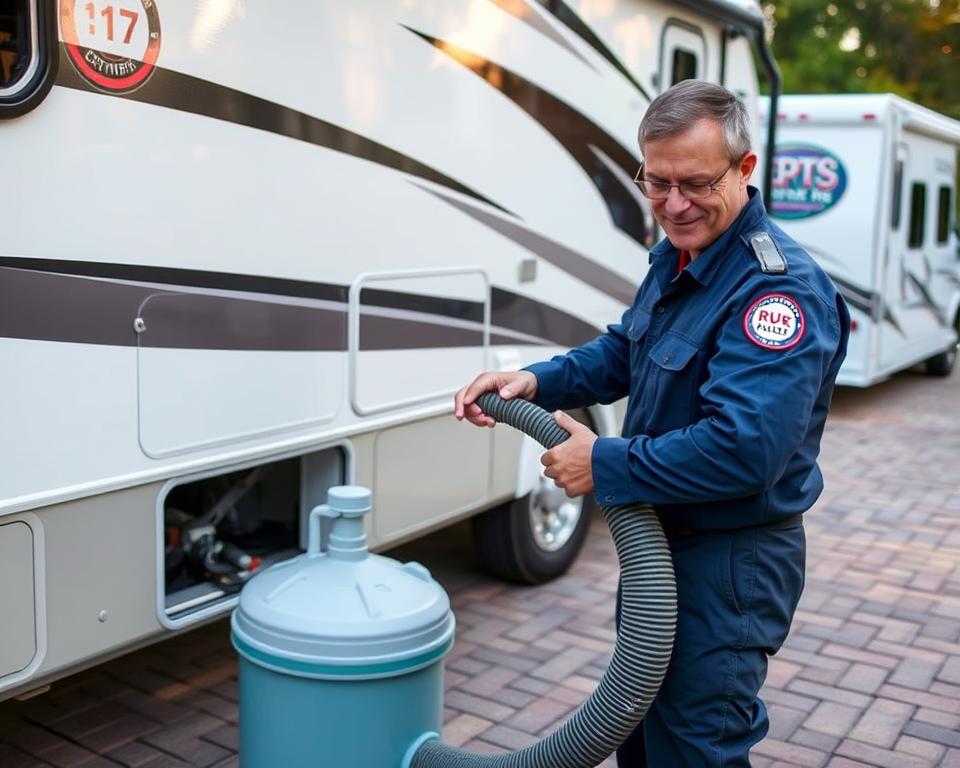RV Tank Emptying: Your Manual to Hassle-Free Disposal
Ever wondered how your motorhome processes waste during outdoor getaways? Proper tank emptying is vital, often more than you think. It’s vital to have your motorhome’s waste system working well for trouble-free trips. This guide explains RV waste systems, the need for septic pumping, and top tips for stress-free excursions. With All in Sanitation’s expertise in pump for RV holding tank, your trips can be as splendid as your destinations.
Top Highlights
- Knowing your RV’s waste system matters greatly for effective septic service.
- Frequent pumping stops unwanted odors and clogs while traveling.
- Following tips prolongs your motorhome’s pipework lifespan.
- Count on All in Sanitation for trustworthy camper tank services.
- Knowing when to pump helps ensure a hassle-free camping experience.
- Safe waste removal is fundamental to conscientious camping.
Understanding RV Waste Systems
On-the-go waste setups in RVs play a vital role in sanitation. These systems typically comprise black and gray water storage. Black water tanks handle sewage from the bathroom. Gray water tanks manage dish and shower runoff. Understanding how each tank works enhances your disposal process.
It’s critical to maintain these systems properly. Neglecting scheduled emptying can cause clogs. Potentially ruining your outdoor excursions. Ensure regular checks to keep both tank types functioning well.
Relying on a reputable black water provider ensures correct dumping. Also, treatments tailored for RV systems can prolong tank life and avert bad smells. Maintaining your sanitation setup enriches your camping freedom.
Why You Need Regular RV Septic Service
Routine septic service ensures a clean and efficient RV. Neglecting wastewater management leads to foul smells, blockages, and system breakdowns. Accumulated waste poses health risks from bacteria. Keeping up with maintenance is thus crucial.
Using a professional service like All in Sanitation ensures eco-friendly waste disposal. They handle your sewage with care and precision. Staying on top of septic servicing keeps your trips worry-free. It ensures your road trips remain enjoyable, avoiding the dangers of overlooked RV septic pumping.
How Often Should You Pump Your RV Septic?
How often you empty tanks influences your RV’s sanitation. It ensures your journey remains uninterrupted. Your pumping schedule depends on occupancy, tank capacity, and usage patterns.
If you camp sporadically, consider emptying black water tanks every few days. Full-time campers often require more frequent dumping. Monitoring tank levels closely can improve your maintenance routine significantly.
Using tank treatments helps you gauge emptying times. By adhering to these disposal recommendations, RV owners can effectively safeguard their systems. Preventing tanks from overflowing not only keeps your environment clean but also prolongs the plumbing lifespan of your RV.

RV Waste Emptying Techniques
RV owners have multiple dumping methods at their disposal. A macerator pump grinds waste into slurry creating a slurry for easier disposal. It enables smooth transfers to dump points. Its efficiency and convenience make it a popular choice.
Residential dumping routes your RV waste into your home septic. It’s essential to verify local regulations to avoid non-compliance with waste disposal laws. Properly executed, it’s eco-friendly and compliant.
Gravity-fed dumping relies on height difference to empty tanks. Each method for RV septic pumping presents unique pros and cons. By understanding these, RV owners can select the most suitable option for their needs, ensuring effective waste management.
RV Waste Disposal Tools
Proper equipment makes tank emptying easier. A top-notch sewer hose is vital for connecting your RV’s waste tank to the dump station. Flexibility and strength are crucial qualities. Quality hoses turn dumping into a quick task.
Include a macerator pump in your gear list. They convert solids into liquid for easier dumping. They’re particularly useful where gravity can’t aid the emptying process.
It’s crucial to maintain your RV septic pumping gear. Always clean hoses and tools post-use to avoid contamination. Proper storage guarantees readiness. Well-maintained gear ensures clean and smooth emptying.
Best Practices for RV Sewer Cleaning
Maintaining a clean and efficient RV waste system is crucial for a pleasant travel experience. To ensure this, it’s important to adopt best practices for RV sewer cleaning. Dump black tanks before gray to optimize rinsing. This process uses the cleaner water to flush out the tanks, preventing clogs and buildup.
Choose enzyme or bacterial additives for superior breakdown. These treatments naturally break down waste, fostering a healthier septic environment. Stay away from harsh chemicals as they can kill the beneficial bacteria, reducing the system’s effectiveness.
Consistently rinsing tanks, hoses, and connectors is key to avoiding odors and blockages. Use separate hoses for black water to reduce contamination risks. It minimizes contamination risks and aids in maintaining system cleanliness.
To ensure best practices are consistently followed, adhere to this checklist:
- Empty black tanks before gray.
- Incorporate bio-additives often.
- Steer clear of caustic cleaners.
- Flush all components post-dumping.
- Inspect the system regularly for leaks or issues.
By adopting these habits, campers enhance system longevity. This leads to more enjoyable road trip experiences.
Upkeep for Trailer Septic Systems
Similar to RVs, mobile homes need regular septic care for lasting performance. Timely maintenance helps avoid costly fixes and downtime. A routine pump every 3–5 years suits most setups, based on usage and capacity.
Proper dumping techniques protect your septic infrastructure. Only introduce safe, approved substances into the system. To reduce damage, use biodegradable products and keep an eye on tank levels. Harsh chemicals should be avoided as they harm the microbes that break down waste.
Scheduling regular professional inspections can catch potential problems early. Proactive inspections maintain seamless functionality. Adhering to these maintenance tips will ensure the septic system of your mobile home remains in excellent condition.
Camper Waste Dumping Advice
Effective trailer wastewater disposal is essential for a smooth RV experience. Start by finding designated dump stations on your route. Verify legal compliance to prevent penalties and eco-harm. Using camper-safe solutions boosts tank health and dumping ease.
Flushing with clean water helps clear tanks completely. A thorough rinse eliminates leftover sludge. This residue can cause odors and blockages. Plus, it aligns with green practices.
Plan ahead for worry-free dumping. By organizing your stops at disposal stations as per your travel plans, you can reduce hassle. This organization aids in streamlining the camper tank pumping process. Some useful tips for waste disposal include:
- Keep tabs on gauges to predict emptying times.
- Use bio-additives to accelerate breakdown and maintain tank health.
- Protect yourself with gloves and sanitization after handling equipment.
RV Tank Additives Explained
Your RV’s sanitation system depends on effective tank treatments. These treatments are made with specific bacteria and enzymes. Designed to decompose solids efficiently. Using them regularly stops bad odors and ensures tanks stay clear, boosting overall performance.
Introducing beneficial bacteria treatments is vital for a balanced microbial environment in RV tanks. They accelerate the natural decomposition process. Less frequent emptying prolongs service intervals.
Choose additives suited to your rig’s specs. Products vary significantly. Eco-friendly options that work well with home septic systems are best. They ensure efficient waste processing and enhance your RV’s waste management system.
| Treatment Form | Active Ingredients | Advantages |
|---|---|---|
| Liquid Treatments | Bio-catalysts | Easy to use; effective waste breakdown |
| Powdered Solutions | Enzymes | Cost-effective; long shelf life |
| Tablet Treatments | Compressed bacteria | Hassle-free; exact dosing |
Pumping Pitfalls
Campers often stumble on simple dumping mistakes. Skipping regular pumping leads to surprises. Resulting in overflow and malfunctions. Misusing cleaners harms beneficial bacteria. Leading to costly fixes and downtime.
Dumping tanks out of sequence is a typical error. Black-then-gray order matters most. Reversing the order invites leaks and smells. It’s also vital not to open the septic tank access lids during home dumping. This task should be left to professionals due to the inherent safety risks.
Ignoring tool upkeep invites equipment failures. Properly maintaining hoses and other essentials ensures an efficient and sanitary RV sewer cleaning process. Awareness of these potential errors can streamline waste management. And keeps campsites fresh and hygienic.
Conclusion
Comprehensive septic manuals are indispensable for RV enthusiasts. They pave the way for hassle-free travels. Regular maintenance and understanding your waste system can enhance your travels significantly. Employing correct methods and gear ensures stress-free camping.
Choosing All in Sanitation for septic services grants tranquility. Their skilled team manages waste with precision and care. Allowing you to focus on memories, not maintenance.
Routine tank emptying is fundamental to conscientious camping. It combines the spirit of exploration with the assurance of a tidy, odor-free environment. This balance ensures a pleasant experience for you and your companions on every journey.


